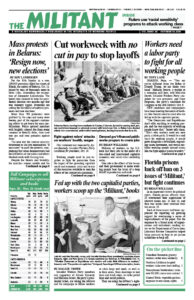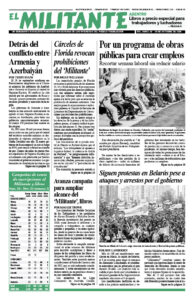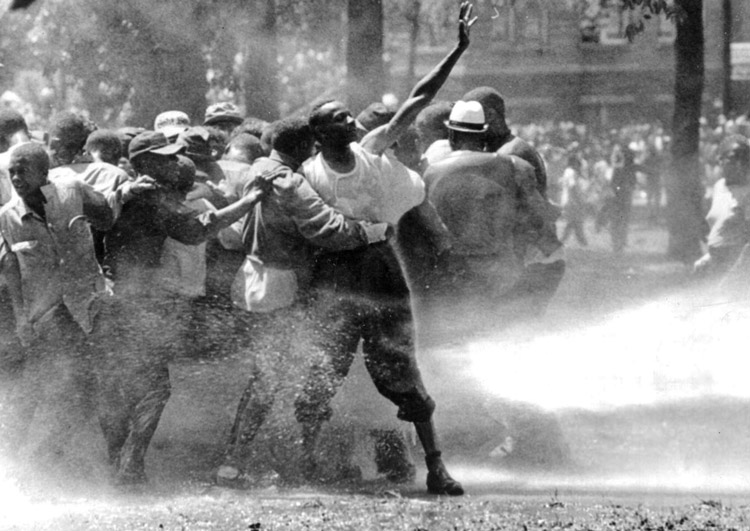Under the false flag of pushing back racism, many government agencies, bosses at some of the largest corporations and school administrators are imposing mandatory “racial sensitivity” programs to shame, silence and intimidate workers who they say are all marked by “white privilege.” They say Caucasian workers are inherently guilty of racism, based not on what they do, but on the color of their skin.
These so-called training programs are a tool developed, marketed and administered by meritocratic middle-class layers to help the employers keep workers they consider ignorant under control. They’re also a tool to elevate the social position and incomes of those who design them.
Attention was focused on this expanding industry when President Donald Trump announced he had suspended such mandatory programs for federal employees at a Sept. 29 debate. More than 2 million federal workers and many more contractors on federal-funded projects had been pushed into such programs before Trump put them on hold.
Trump said he had his own education program, which is based on celebrating “patriotic American values,” and promotes U.S. imperialism. It tries to convince workers we are all “fellow Americans,” and to disguise the reality of sharply different class interests of the capitalist rulers and working people in the U.S.
During the debate Joe Biden, Trump’s Democratic Party challenger, said he backed “racial sensitivity” programs, saying, “People have to be made aware of what other people feel like.” Officials of the American Federation of Government Employees, a union representing 700,000 workers, also back the programs, claiming they help ensure “every worker is treated with dignity.”
But these “racial sensitivity” programs aren’t aimed at raising consciousness. They promote a world view where history isn’t rooted in the conflict of classes, but is defined instead by race. And this view is pushed with an attitude.
Last year New York City rolled out a new $23 million “implicit bias” training program for all Department of Education workers. “Anybody that feels that somehow that process is not beneficial,” says Richard Carranza, New York Schools chancellor, “they are the ones that need to reflect even harder upon what they believe.”
In Albuquerque, New Mexico, engineer Casey Peterson went to his bosses to object to the political character of a training program he underwent at Sandia nuclear laboratory. Only the company’s white male employees were told to participate. His bosses told him he was refusing to recognize his own “unconscious biases” and needed to be “educated.”
Outraged at this demeaning response, Peterson posted a video to YouTube Aug. 25. He says the company’s list of “100 Things White People Can Do for Racial Justice” tells workers, “Those who are NOT practicing anti-racism are perpetrating white supremacy” and that “the validity of your ideas is dependent on the color of your skin.”
As the number of people watching his video rose, his bosses put Peterson on administrative leave, claiming he posed a “security threat.”
Based on ‘critical race theory’
The ideology that underlies these training programs are drawn from what academics call “critical race theory.” One of its pioneers, Derrick Bell, belittled the conquests of the Black-led working-class movement for civil rights that tore down Jim Crow segregation, describing them as “short-lived victories that slide into irrelevance as racial patterns adapt in ways that maintain White dominance.”
His conclusion is that struggle isn’t worth it, results are ephemeral and only a steady diet of browbeating can control workers’ inborn racist nature.
The advice from Bell and others who push this anti-historical view is to turn your back on the amazing record of struggles waged by Blacks in this country. These include the revolutionary war to end slavery; the fight to establish governments of Radical Reconstruction in its aftermath; farmers’ struggles in the 1920s; the sizable integration of Black workers into industry during the rise of the movement for industrial unions; and the mass working-class movement to end segregation. Black workers led mass actions that changed forever the attitudes, outlook and self-worth of millions of workers, both Black and Caucasian, laying the basis for new battles to come.
This was reflected in the mass response in cities, towns and rural areas earlier this year to join in protests against the cop killing of George Floyd in Minneapolis.
These protests, and others, were dealt a death blow by the leaders of Black Lives Matter, who champion looting and thuggery and who promote the same outlook as Bell.
Efforts to demonize working people who are Caucasian as innately reactionary are reinforced by the New York Times 1619 Project, which has been widely adopted in classrooms across the country. Packaged as “history,” this project joins in minimizing the importance of the centurieslong record of struggle against racial oppression. Instead, its author, Nikole Hannah-Jones, says, “Anti-Black racism runs in the very DNA of this country.”
The fact is that as a result of these struggles, there is less racism among working people today than ever. But as long as the capitalist ruling families hold power, they will continue to foster every form of prejudice to try to deepen divisions among us to perpetuate their rule.
“Racial sensitivity” training is one more tool they are grabbing to continue to do so. It also provides lucrative positions for those who promote and administer such programs, who are part of a growing parasitic social layer that are an integral social prop for continued capitalist exploitation and oppression.
Their ideology is promoted by a significant wing of the capitalist rulers — like the Sulzberger family that owns the New York Times and fervently backs the 1619 Project, despite growing evidence it is built on distortions of history. They see its authors and promoters as an important part of advancing the rule of their class.
As working people wage struggles against the deepening economic and social crisis we face today, we need to learn more about the history of our class and the lessons of previous battles, including the fight for Black rights. Doing so arms us for the mighty class struggles to come to overthrow capitalist rule, establish a workers and farmers government, and use it as the strongest weapon possible to end racist discrimination and violence once and for all.


